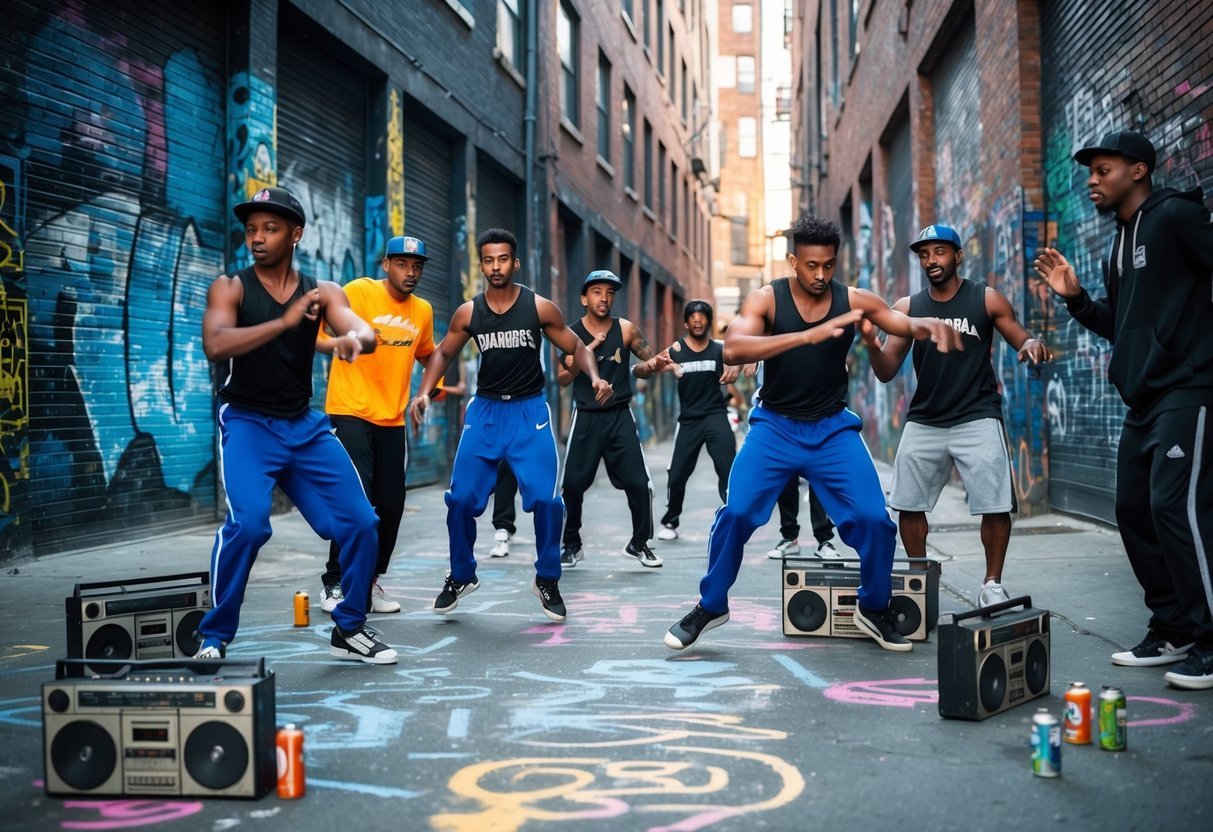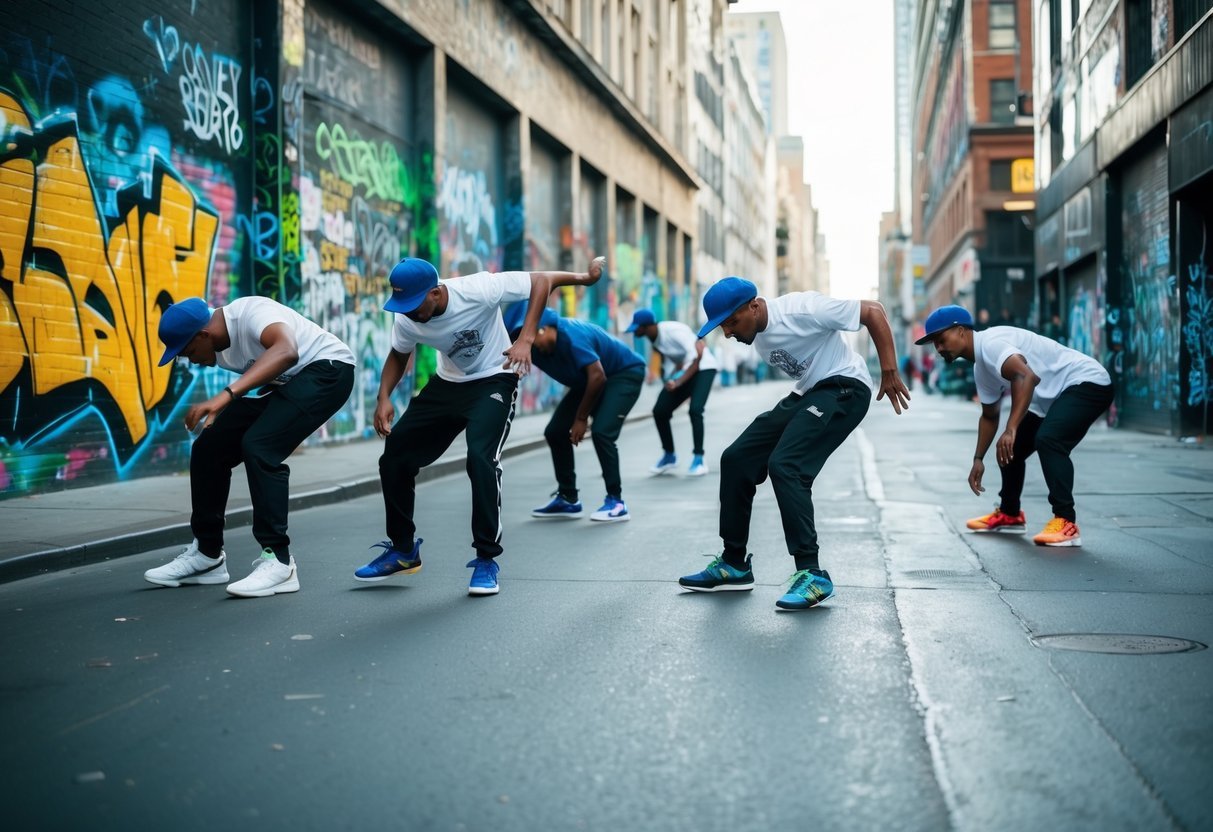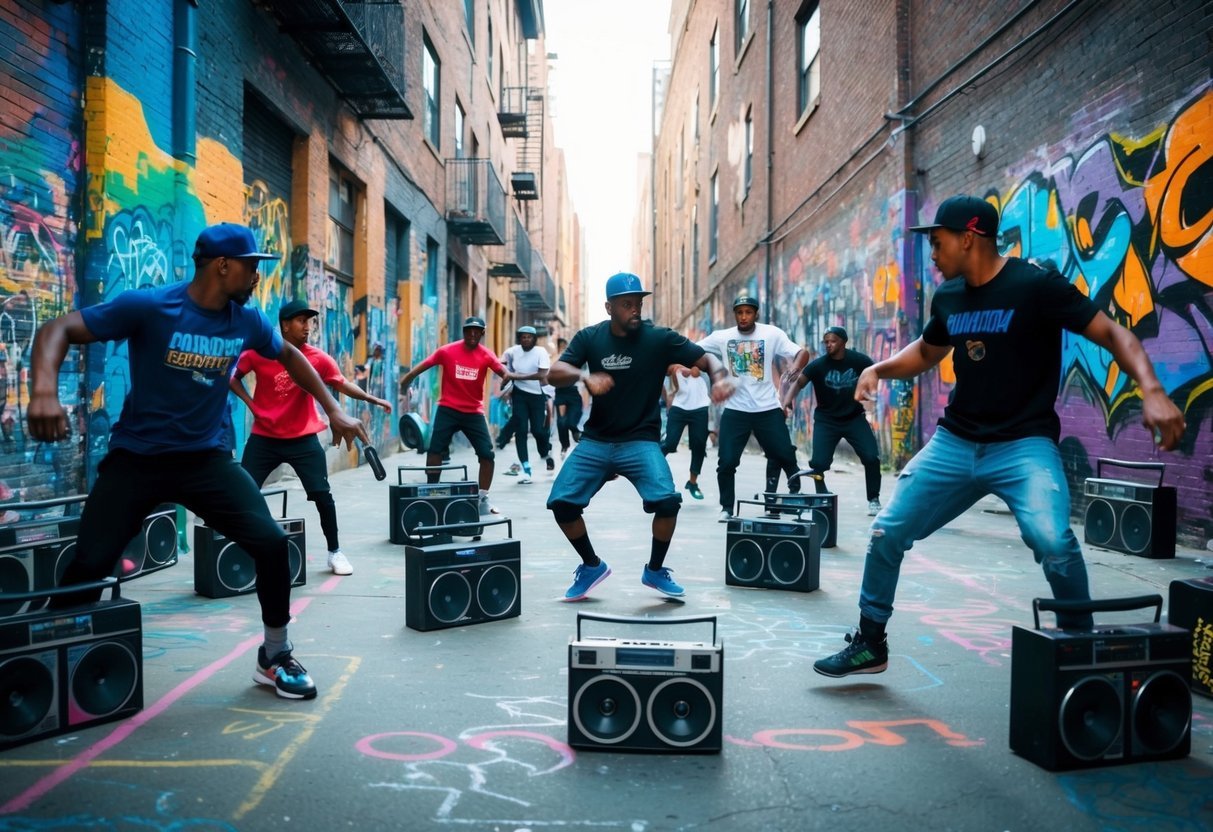Breakdancing, a vibrant and dynamic form of street dance, has captivated audiences worldwide for decades.
From its humble beginnings in the Bronx to its upcoming Olympic debut, this art form has undergone a remarkable journey.

You’ll discover fascinating insights into breakdancing’s rich cultural heritage and historical significance in this article. Get ready to explore the key moments, influential figures, and evolving styles that have shaped this iconic dance form.
Whether you’re a seasoned b-boy or b-girl or just curious about this high-energy sport, you’re in for an exciting ride through the world of breaking.
1) The Bronx beginnings
Breakdancing was born in the Bronx back in the 1970s.
It’s wild to think that this global phenomenon started in just one NYC borough.
The Bronx was going through some tough times back then.
But out of that struggle came some serious creativity.
Kids in the neighborhood started busting out these crazy moves at block parties.
You’d see them spinning on their heads and freezing in impossible positions.
It was like nothing anyone had seen before.
This new style of dance quickly became one of the four pillars of hip hop culture.
At first, they called it “breaking” or “b-boying.” The term “breakdancing” came later, cooked up by the media.
But whatever you call it, there’s no denying its Bronx roots.
These street dancers weren’t just moving their bodies.
They were expressing themselves and reflecting their world.
It was raw, it was real, and it was about to take over the globe.
2) Cool Herc’s house parties
DJ Kool Herc’s house parties in the Bronx kicked off something huge.
Back in the early 70s, this guy was throwing some epic back-to-school jams that would change the game forever.
Picture this: It’s August 11, 1973, and you’re at 1520 Sedgwick Avenue.
Herc and his sister Cindy are hosting a party in their building’s rec room.
The admission? A quarter for girls, 50 cents for guys.
Not bad for a night that would go down in history.
Herc’s parties were different.
He’d isolate and extend the instrumental breaks in funk songs, creating the perfect backdrop for dancers to show off their moves.
This technique, called the “Merry-Go-Round,” laid the foundation for breakdancing.
These gatherings weren’t just about the music.
They marked a shift in Bronx culture.
Instead of gangs, you now had DJ and dance crews taking center stage.
Herc’s own crew, the Herculords, became the new standard of cool.
So next time you’re busting out some breakdancing moves, remember where it all started – at Cool Herc’s house parties in the Bronx.
3) Battle of the Year

Ever heard of Battle of the Year? It’s a big deal in the breaking world.
This international breakdancing competition kicked off in 1990, originally called the International Breakdance Cup.
Back then, only a handful of crews entered.
But now? It’s huge.
Crews from all over the globe come to show off their best moves and compete for the top spot.
You might wonder what makes Battle of the Year special.
Well, it’s not just about individual skills.
It’s all about teamwork.
Crews have to bring their A-game and work together to impress the judges.
The event has grown so much over the years.
It’s not just a competition anymore – it’s a celebration of breaking culture.
You’ll see incredible performances, feel the energy of the crowd, and maybe even pick up some new moves.
If you’re into extreme sports and love the idea of dance battles, Battle of the Year is something you don’t want to miss.
It’s a chance to see the world’s best breakers push the limits of what’s possible on the dance floor.
4) The influence of James Brown
You can’t talk about breakdancing without mentioning the Godfather of Soul, James Brown.
His electrifying moves and funky beats laid the groundwork for what would become b-boying.
When you watch old footage of Brown performing, you’ll notice his fancy footwork and spins.
These moves inspired many of the foundational steps in breakdancing.
Brown’s music also played a huge role.
His songs, with their rhythmically driven aesthetic, became the perfect backdrop for breakdancers to show off their skills.
You might not realize it, but when you’re popping and locking, you’re channeling some of that James Brown energy.
His influence on funk music directly shaped the sounds that breakdancers groove to.
As the inventor of funk, Brown’s impact goes beyond just the moves.
His music helped create the culture that breakdancing thrives in.
Next time you’re at a breakdancing battle, listen closely.
You might just hear echoes of James Brown’s legendary performances in the beats and the dancers’ styles.
5) The Rock Steady Crew
You’ve probably heard of the Rock Steady Crew if you’re into breakdancing.
These guys were pioneers of breakdancing who helped put the style on the map.
Founded in 1977 in the Bronx, New York City, the Rock Steady Crew quickly made a name for themselves.
They were known for their impressive style and acrobatic skills, which helped define breaking as we know it today.
The crew gained fame for their unique moves, including head spins and freezes.
You might’ve seen them in action if you’ve watched the movie Flashdance.
Rock Steady Crew didn’t just stay local.
They took their skills global, spreading the love for breakdancing worldwide.
Today, they’ve got chapters in the UK, Italy, and Japan.
Even now, the crew keeps pushing boundaries.
They hold an annual anniversary event and stay active in their community.
If you’re looking to learn some moves, you might catch them teaching dance classes to keep the next generation spinning.
6) B-boying in the 1980s
The 1980s saw breakdancing explode into mainstream popularity.
You couldn’t turn on the TV or go to the movies without seeing b-boys and b-girls busting moves.
Hollywood caught on quick, churning out films like “Breakin'” and “Beat Street.” These flicks introduced breaking to audiences far beyond the streets of New York.
Music videos became a huge platform for showcasing breaking skills.
You’d see crews spinning and freezing alongside your favorite pop stars.
The competitive aspect of breaking really took off during this decade.
Battles got bigger and more intense, with crews facing off to prove who had the freshest moves.
New styles and techniques emerged as b-boys and b-girls pushed the boundaries.
Power moves like windmills and headspins became crowd favorites.
Breaking even made its way into the world of advertising.
You’d see b-boys popping and locking to sell everything from soda to sneakers.
By the end of the 80s, breaking had firmly established itself as a global phenomenon.
What started in the Bronx had become a worldwide movement.
7) Breakin’ (1984 movie)
You might know “Breakin'” as the flick that brought breakdancing to the big screen.
This 1984 hit was one of the first movies to showcase the hip-hop dance style to a mainstream audience.
With a tiny budget of less than $1 million, “Breakin'” became a pop-cultural phenomenon.
It’s crazy to think how this low-budget film took theaters by storm.
The movie tells the story of a jazz dancer who teams up with two street dancers.
Together, they enter a dance competition and show off their killer moves.
You might spot a young Ice-T in his acting debut.
He plays a club MC, adding some authentic street cred to the film.
“Breakin'” wasn’t just about the moves.
It brought the whole street culture vibe to life on screen.
The music, the fashion, and the attitude – it was all there.
The film’s success sparked a wave of breakdancing movies.
But “Breakin'” will always be remembered as the one that started it all.
It’s a time capsule of 80s street culture that still gets people hyped today.
The Roots of Breakdancing

Breakdancing emerged from the vibrant streets of New York City in the 1970s.
It blended elements from various dance styles and cultural influences to create a unique form of artistic expression.
Origins in the Bronx
The Bronx played a crucial role in the birth of breakdancing.
In the early 1970s, DJ Kool Herc introduced innovative music techniques that laid the foundation for hip-hop culture.
He extended instrumental breaks in songs, giving dancers more time to showcase their moves.
You’d see young African American and Latino dancers gathering at block parties, spinning on the ground and freezing in eye-catching poses.
These moves became known as “breaking” or “b-boying.”
The dance style quickly spread through the neighborhoods, becoming a way for youth to express themselves and compete peacefully.
Crews formed, battling each other with increasingly complex and acrobatic moves.
Influences from Other Dance Styles
Breakdancing didn’t develop in isolation.
You can spot influences from various dance forms and physical activities:
- Capoeira: The Brazilian martial art contributed fluid, acrobatic movements.
- Gymnastics: Many power moves draw inspiration from gymnastic floor routines.
- Funk styles: The electric boogaloo and popping added isolations and fluid body control.
- Martial arts: Kung fu movies found their way into breaking, inspiring kicks and spins.
James Brown’s energetic stage presence also inspired early b-boys.
His fast footwork and dynamic splits became staples of breakdancing vocabulary.
As you practice, you’ll notice how these diverse influences blend seamlessly in breakdancing, creating a rich and complex dance form.
Cultural Impact of Breakdancing

Breakdancing has left an indelible mark on global culture, spreading far beyond its origins in the Bronx.
It’s become a worldwide phenomenon, influencing music, fashion, and even the Olympics.
Global Spread and Popularity
You might be surprised to learn that breakdancing has spread to nearly every corner of the globe.
From busy streets in Tokyo to underground clubs in Berlin, b-boys and b-girls are busting moves everywhere.
This dance style has bridged cultural gaps, uniting people through a shared love of movement and music.
It’s not just about the dance – it’s a lifestyle that’s influenced fashion, art, and language.
Breakdancing competitions now draw huge crowds worldwide.
Major events like the Red Bull BC One attract top talent from dozens of countries.
The dance’s global appeal even led to its inclusion in the 2024 Paris Olympics.
Representation in Media
You’ve probably seen breakdancing in movies, TV shows, and music videos.
It’s been a staple of pop culture since the 1980s. Films like “Breakin'” and “Beat Street” helped propel breakdancing into the mainstream.
These media representations have both popularized and sometimes misrepresented the culture.
While they’ve increased visibility, they don’t always capture the depth and complexity of the breakdancing community.
Music videos have been particularly influential.
Artists from Michael Jackson to BTS have incorporated breaking into their choreography, exposing millions of fans to the style.
Video games like “Dance Dance Revolution” and “B-Boy” have also played a role, letting you try out virtual breaking moves from your living room.
Frequently Asked Questions

Breakdancing’s history is rich with iconic figures, pivotal moments, and cultural significance.
Let’s explore some key aspects of this dynamic dance form that has captivated audiences worldwide.
Who’s considered the pioneer of breakdancing?
While many dancers contributed to breakdancing’s development, DJ Kool Herc is often credited as a pioneer.
His innovative use of breaks in music laid the foundation for breakdancing moves.
What era did breakdancing first make its mark?
Breakdancing emerged in the early 1970s in the Bronx, New York City.
It quickly became an integral part of hip-hop culture, spreading through block parties and street performances.
Can you list five quick facts about breakdancing tradition?
- Breakdancing battles are a core part of the culture.
- The term “b-boy” or “b-girl” refers to breakdancers.
- Power moves like windmills and headspins are crowd favorites.
- Crews often compete against each other in organized events.
- Breakdancing will debut as an Olympic sport in 2024.
What’s the story behind how breakdancing got its name?
The name “breakdancing” comes from dancing during the “break” in a song.
DJs would loop this percussive section, giving dancers more time to show off their moves.
Why is breakdancing significant to its cultural roots?
Breakdancing provided a creative outlet for urban youth.
It became a way to express identity, compete non-violently, and build community in neighborhoods facing socioeconomic challenges.
How has breakdancing changed from its inception to today?
Breakdancing has evolved from street corners to global stages.
You’ll now find it in music videos, commercials, and even mainstream movies.
The moves have become more acrobatic, and the competitive scene has grown into international championships.


